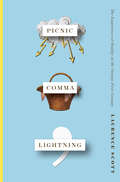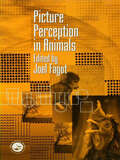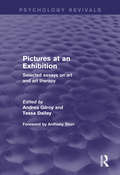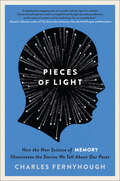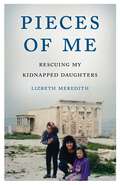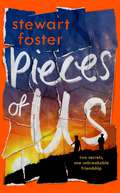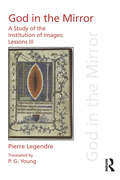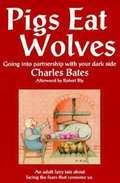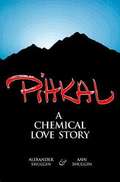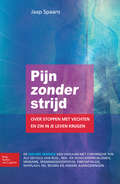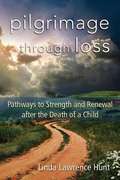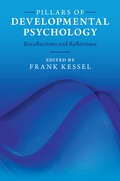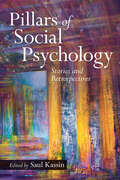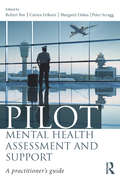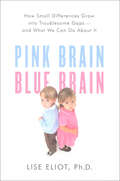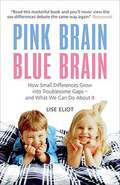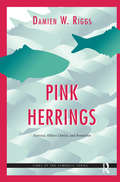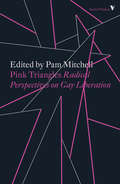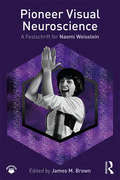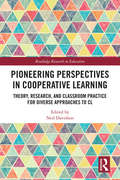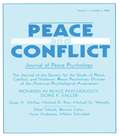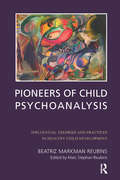- Table View
- List View
Picnic Comma Lightning: The Experience Of Reality In The Twenty-first Century
by Laurence ScottIn Vladimir Nabokov’s Lolita, Humbert Humbert offers a memorably brief account of his parents’ death: “picnic, lightning.” <P><P>Picnic Comma Lightning, too, opens with death—that of Laurence Scott’s mother—because, for a philosopher, death raises a profound existential question: How do we know what is real, especially when we have come to question the reality of so many of our day-to-day experiences? <P><P>Writing from the intersection of philosophy, politics, and memoir, Scott transforms his personal meditation on loss into a beguiling exploration of what it means to exist in the world today. <P><P>It used to be that our lives were rooted in reasonably solid things: to people, places and memories. Now, in an age of online personas, alternative truths, constant surveillance and an increasingly hysterical news cycle, our realities are becoming flimsier and more vulnerable than ever before. <P><P>Scott’s far-ranging examination charts the ways our traditional mental models of the world have started to fray. He ponders how ubiquitous cameras reframe our private lives (an event only exists once someone posts the video), how mysterious algorithms undermine our attempts at self-definition through their own data-driven portraits, and what happens in those moments when our illusions about reality are ruptured by incontrovertible facts (like the death of a parent or a bolt of lightning). <P><P>“A report from the front line of the online generation” (Sunday Times), Picnic Comma Lightning is an essential account of how we’ve started to make sense of our strange new world.
Picture Perception in Animals
by Joël FagotAnimal researchers commonly present pictures to their subjects, usually birds or monkeys, in order to infer how natural objects are perceived and conceptualised, or to discover the brain mechanisms underlying these abilities. This unique book questions the premise of this experimental approach and asks whether or not pictures can be considered as ecologically valid and realistic stimuli for animals.Leading researchers in comparative psychology and neuroscience address such questions as: "Can animals recognise objects of scenes in pictures despite variations in viewpoints?; "How do animals perceive faces?" and "Is there an equivalence, in animals' minds, between pictures and the objects they represent?". The result is an authoritative and cutting-edge survey of current knowledge in the field, which underlines the advantages, limits and risks of using pictures to infer cognitive abilities or brain mechanisms in animal studies.Picture Perception in Animals will be essential reading for comparative psychologists, anthropologists, and neuroscientists working in picture perception.
Pictures at an Exhibition: Selected Essays on Art and Art Therapy (Psychology Revivals)
by Tessa Dalley Andrea GilroyOriginally published in 1989 Pictures at an Exhibition brings together a rich collection of essays, representing the diversity of views and approaches among professionals towards art and psychoanalysis and art therapy. The editors, both of whom are practising art therapists and art therapy educators, have arranged the contributions so that they may be read in a way similar to looking at pictures in a gallery: they can be glanced at briefly or lingered over, read consecutively or dipped into at random. Artists, art therapists, psychotherapists, psychiatrists and art historians will all find something of interest, and something to stimulate thought and discussion. Contributions include innovative papers on the relationship between artists’ lives and the subject-matter of their work; the work of Kandinsky, Picasso, Magritte, Moore, Lear and Genet is looked at in particular. Generously illustrated, the book also highlights the importance of language and culture in attempting to understand imagery. Each contribution is linked by editorial comments drawing together the threads of concern which are common to art and psychiatry.
Pieces of Light: How the New Science of Memory Illuminates the Stories We Tell About Our Pasts
by Charles FernyhoughIn a blend of memoir and science, a psychologist presents a “thoughtful exploration” of autobiographical memory (Booklist).A new consensus is emerging among cognitive scientists: rather than possessing fixed, unchanging memories, we create new recollections each time we are called upon to remember. As psychologist Charles Fernyhough explains, remembering is an act of narrative imagination as much as it is the product of a neurological process. In Pieces of Light, he illuminates this compelling scientific breakthrough in a series of personal stories, each illustrating memory’s complex synergy of cognitive and neurological functions.Combining science and literature, the ordinary and the extraordinary, this fascinating tour through the new science of autobiographical memory helps us better understand the ways we remember—and the ways we forget. Book of the Year: Sunday Times, Sunday Express, and New Scientist
Pieces of Me: Rescuing My Kidnapped Daughters
by Lizbeth MeredithNow a Lifetime television movie starring Sarah Drew, Stolen By Their Father was adapted from the story of Pieces of Me: Rescuing My Kidnapped Daughters about a young mother and her daughters face the unimaginable consequences after leaving abuse. In 1994, Lizbeth Meredith said good-bye to her four- and six year-old daughters for a visit with their non-custodial father only to learn days later that they had been kidnapped and taken to their father's home country of Greece. Twenty-nine and just on the verge of making her dreams of financial independence for her and her daughters come true, Lizbeth now faced a $100,000 problem on a $10 an hour budget. For the next two years fueled by memories of her own childhood kidnapping, Lizbeth traded in her small life for a life more public, traveling to the White House and Greece, and becoming a local media sensation in order to garner interest in her efforts. The generous community of Anchorage becomes Lizbeth's makeshift family?one that is replicated by a growing number of Greeks and expats overseas who help Lizbeth navigate the turbulent path leading back to her daughters.
Pieces of Us
by Stewart FosterTwo secrets, an unbreakable bond . . . a powerful and heartbreaking love letter to a life-changing friendship, from award-winning author, Stewart Foster. I wish you were here, because maybe this isn&’t a story, or a diary. Perhaps it&’s just the longest thank you letter a friend could ever write. As the summer before college begins, Jonas is hiding a secret. He suffers with bulimia, but no one knows. Not even he knows how bad it really is. Until he meets Louis, a confident dreamer who believes in a better future for Jonas and together they enjoy a sun-kissed summer filled with music, memories and life-changing moments. But when tragedy strikes, Jonas must decide if he has the strength to face things alone . . . Writing from personal experience, an award-winning author shines an important light on difficult themes of illness, mental health, and grief in a redemptive story of friendship, for readers of Meg Rosoff and Sarah Crossan. Warning: contains some themes that readers may find upsetting, including disordered eating.
Pierre Legendre Lessons III God in the Mirror: A Study of the Institution of Images (Discourses Of Law Ser.)
by Pierre LegendreIn the context of our increasingly global legal order, Pierre Legendre’s God in the Mirror reconsiders the place of law within the division of existing bodies of knowledge. Navigating the texts of Ovid, Augustine, Roman jurists, medieval canon lawyers, Freud, Lacan, the notebooks of Leonardo de Vinci, and the paintings of Magritte, this third volume of Pierre Legendre’s Lessons focuses on the relation of the subject to the institution of images. Legendre tracks the origins and vicissitudes of the specular metaphor within western history, carrying out a critique of its dependence on the discourse of the Imago Dei. A crucial landmark within Legendre’s ongoing reconsideration of a medieval ‘revolution of interpretation’, this book dissociates the western normative tradition from its mythic foundation, separating theology and law. It thereby documents the advent of modern rational doubt, as a new legal foundation or ground: one that, for Legendre, was not only a revolutionary invention, but one that produced the modern European idea of the State.
Pigs Eat Wolves: Going into Partnership with Your Dark Side
by Charles BatesPigs Eat Wolves challenges us to accept, as part of our being, those characteristics which we would like to see only in others. We embody the naive and wishful thinking, the dutiful and plodding sense of responsibility taking, the cautious and fearful wondering, and the outrageous and unpredictably violent side of life. To see and accept within ourselves the full range of our humanity is all that is asked by this enlightening, entertaining, shocking, and delightful recasting of this classic tale.
Pihkal: A Chemical Love Story
by David E. Nichols Alexander Shulgin Ann ShulginThis book contains two parts. The first part is a personal story of exploration by the renowned chemist Alexander Shulgan. The second part is even more interesting - it is a summery of years and years of psychadelic research on phenthalamines. Each chemical contains information on it's synthesis, dosage, effects, and commentary. Shulgan explored the known phenthalamines, then produced HUNDREDS of completely new chemicals and analogs in his quest to explore a class of chemicals that ranges from mescaline to MDMA (ecstacy).
Pijn zonder strijd
by Jaap SpaansZelfhulpboek gebaseerd op de methode van Acceptance and Commitment Therapy (ACT), toegepast op chronische pijn. Doel van het boek is de lezer te leren de pijn te aanvaarden en ermee om te gaan. Aanvaarden van chronische pijn houdt in dat je bereid bent pijn en alle gedachten en gevoelens die je daarbij hebt, waar te nemen, en er niet meer tegen te vechten. Dat verbetert de kwaliteit van leven, ook al is de pijn nog steeds aanwezig.
Pilgrimage through Loss: Twelve Pathways to Strength and Renewal after the Death of a Child
by Linda Lawrence HuntThe death of a child immerses parents into a life-long challenge of living with one of life's most heartbreaking losses. Pilgrimage through Loss tells the story of one family's journey, along with interviews from thirty other mothers and fathers who add their voices to the silences that often surround suffering in our 'mourning-avoidant' culture. Hunt illuminates the varied pathways parents eventually discover that open their lives to strength and healing. Rather than prescribing a path that will lead to recovery, Hunt encourages parents to find the pathways that work for them as they seek to engage life again with meaning and hope. Each chapter includes questions for reflection and discussion, plus recent research on grief and loss. Pilgrimage through Loss not only helps grieving parents, it also provides an insightful resource for those wanting to understand and come alongside a family in grief.
Pillars of Developmental Psychology: Recollections and Reflections
by Frank KesselEmbark on a journey through the rich tapestry of developmental psychology with 'Pillars of Developmental Psychology.' This collection reveals personal histories of influential scholars, the living 'pillars,' whose decades-long contributions have shaped the discipline. The book deepens the argument that a complete understanding of the field requires the human narratives that have woven its fabric, complementing and going beyond analytical views. These 'pillars' not only recount the achievements and challenges of their journeys, but also highlight how their work can inspire future generations. This reflective anthology resonates across disciplines, offering invaluable insights for scholars and students alike. A framing preface, tantalizing abstracts, illuminating chapters, and a closing commentary amplify the significance of these scholars' contributions, revealing overarching themes in personal, inter-personal, institutional, socio-political, and intellectual dimensions. "Pillars of Developmental Psychology" is a testament to the enduring impact of these luminaries and a roadmap for the dynamic future of developmental inquiry.
Pillars of Social Psychology: Stories and Retrospectives
by Saul KassinThis collection of first-person accounts from legendary social psychologists tells the stories behind the science and offers unique insight into the development of the field from the 1950s to the present. One pillar, the grandson of a slave, was inspired by Kenneth Clark. Yet when he entered his PhD program in the 1960s, he was told that race was not a variable for study. Other pillars faced first-hand a type of sexism that was hardly subtle, when women were not permitted into the faculty dining room. Still others have lived through a tremendous diversification of social psychology, not only in the United States but in Europe and Asia, that characterizes the field today. Together these stories, always witty and sometimes emotional, form a mosaic of the field as a whole – its legends, their theories and research, their relationships with one another, and their sense of where social psychology is headed.
Pills, Skills, and Will
by Stephen Luce Jr.My psychologist, Dr. J. Mark Pratt, says &“What you do most is what you do best.&” Certainly, full-time paid employment takes up most of my time, and I am so grateful for that. Coming in close second, however, is mental health treatment. Appointments with psychiatrists/psychologists, mental health support groups, obtaining required blood work from the lab, filling pharmacy prescriptions, going to church, reading literature, and praying/meditating. Also common is doing volunteer work, helping friends and family with tasks, and listening to them when they are troubled. These activities give me positive thoughts that I am contributing to society and help keep me away from the negativity that has been a hallmark of my mental illness.Thus it has become a life that I truly believe is one worth living. In the early stages of recovery (the late 1990s) I did not share this view. But I survived those tumultuous days and have now entered into an expansive place where peace, even joy, is a common experience.The psychiatric and psychological treatments that have made this possible cost my mom, Gwen, a lot of money. Although, I have been able to remove this burden from her more recently. It occurred to me that if I could write a book delineating the various aspects of my treatment program, I could share these helpful concepts with others, virtually for free. That is the spirit in which this book is published, and I hope you can utilize it for increased mental health and well-being!
Pilot Mental Health Assessment and Support: A practitioner's guide
by Robert Bor, Carina Eriksen, Margaret Oakes and Peter ScraggThe presentation of mental illness at work has different implications and consequences depending on the specific nature of the job, work context, regulatory framework and risks for the employee, organisation and society. Naturally there are certain occupational groups where human factors and/or mental illness could impair safety and mental acuity, and with potentially devastating consequences. For pilots, the medical criteria for crew licensing are stipulated by regulatory aviation authorities worldwide, and these include specific mental illness exclusions. The challenge of assessment for mental health problems is, however, complex and the responsibility for psychological screening and testing falls to a range of different specialists and groups including AMEs (authorised aviation medical examiners), GPs and physicians, airline human resources departments, psychologists, human factor specialists and pilots themselves. Extending and developing the ideas of Aviation Mental Health (2006), which described a range of psychological issues and problems that may affect pilots and the consequences of these, this book presents an authoritative, comprehensive and practical guide to modern, evidence-based practice in the field of mental health assessment, treatment and care. It features contributions from experts in the field drawn from several countries, professions and representing a range of aviation-related organisations, displaying a range of different skills and methods that can be used for the clinical assessment of pilots and in relation to specific mental-health problems and syndromes.
Pink Brain, Blue Brain: How Small Differences Grow Into Troublesome Gaps—And What We Can Do About It
by Lise EliotA scientific study of the differences between boys & girls that tackles damaging gender stereotypes and offers practical guidance for parents & educators.In the past decade, we’ve heard a lot about the innate differences between males and females, so we’ve come to accept that boys can’t focus in the classroom and girls are obsessed with relationships. In Pink Brain, Blue Brain, neuroscientist Lise Eliot turns that thinking on its head. Presenting the latest science from birth to puberty, Eliot zeroes in on the precise differences between boys and girls, reining in harmful stereotypes. She argues convincingly that infant brains are so malleable that what begin as small differences at birth become amplified over time, as parents and teachers—and the culture at large—unwittingly reinforce gender stereotypes.The good news is that by appreciating how sex differences emerge—rather than assuming them to be fixed biological facts—we can help all children reach their fullest potential. Eliot offers teachers and parents concrete ways to help close the troubling gaps between boys and girls ultimately end the gender wars that currently divide us.
Pink Brain, Blue Brain: How Small Differences Grow into Troublesome Gaps - And What We Can Do About It
by Lise EliotTurning conventional thinking about gender differences on its head, Lise Eliot issues a call to close the troubling gaps between boys and girls and help all children reach their fullest potential. Drawing on years of exhaustive research and her own work in the field of neuroplasticity, Eliot argues that infant brains are so malleable that small differences at birth become amplified over time as parents, teachers, and the culture at large unwittingly reinforce gender stereotypes. Indicating points of intervention where social pressures can be minimised, she offers concrete solutions for helping everyone grow into wellrounded individuals.
Pink Herrings: Fantasy, Object Choice, and Sexuation (The\lines Of The Symbolic Ser.)
by Damien W. RiggsPink Herrings engages in a re-examination of six of Freud's cases via Lacan's account of sexuation. Specifically, the book outlines a theoretical framework in which sexuation is understood as a 'choice' made in response to the fact of the sexual non relationship. In making this choice, unconscious fantasy allows for the circulation of object a, which bear traces of jouissance. Drawing upon Lacan's distinction between phallic and other jouissance, Pink Herrings examines the four positions outlined in Lacan's formula of sexuation, and maps these onto the six case studies. In so doing, Pink Herrings not only brings new life and insights to the cases, but also clears a path to what is referred to as a 'clinic of sexuation'. Such a clinic would not replace existing Lacanian psychoanalytic practice (with its focus on the structures of neurosis, perversion and psychosis), but instead provide additional avenues through which to explore the operations of fantasy.
Pink Tourism: Holidays of Gay Men and Lesbians
by Howard L. HughesThis book presents a detailed picture of gay and lesbian tourism from, primarily, a marketing perspective and examines how marketing activity engages with and affects social issues relating to homosexuality. It gives an overview of the nature of homosexuality and relevant issues that bear upon tourism and marketing.
Pink Triangles: Radical Perspectives on Gay Liberation
by Pam Mitchell"To link socialism and lesbianism is to link the unpopular with the taboo"Though the interpretations of the interplay between sexism and capitalism, between the personal and the political, vary across this spectacularly wide ranging collection, each essay shares two fundamental premises. First, that the oppression of gays and lesbians is not an isolated case, and therefore their struggle is necessarily part of a larger movement for social liberation. And second, that the experience of gays and lesbians uphold the basic tenants of a foundational marxism, and that they are uniquely placed to contribute to a revitalization of marxist theory.
Pioneer Visual Neuroscience: A Festschrift for Naomi Weisstein
by James M. BrownThis book honors Naomi Weisstein’s foreshortened span of work published from 1964 to 1992. Naomi Weisstein was a pioneer in the areas we now call visual neuroscience, visual cognition, and cognitive neuroscience. Her enthusiastic pursuit of the mind was infectious, inspiring many others to take up the challenge. Despite her time as an active researcher being cut short, Weisstein’s impact was far reaching and long lasting, and many of her ideas and insights foreshadowed today’s active areas of inquiry into the inner workings of the mind. Comprising contributions from leading scholars in the field, Pioneer Visual Neuroscience outlines Weisstein’s many contributions to the study of visual perception and processing and their effects on the field today.This volume will be of interest to anyone interested in visual perception, visual cognition, and cognitive neuroscience.
Pioneering Perspectives in Cooperative Learning: Theory, Research, and Classroom Practice for Diverse Approaches to CL (Routledge Research in Education)
by Neil DavidsonOffering first-hand insights from the early originators of Cooperative Learning (CL), this volume documents the evolution of CL, illustrating its historical and contemporary research, and highlights the personal experiences which have helped inspire and ground this concept. Each of the chapters in Pioneering Perspectives in Cooperative Learning foregrounds a key approach to CL, and documents the experiences, research, and fruitful collaborations which have shaped and driven their development. Contributions from leading scholars include Aronson, Davidson, Kagan, Johnson & Johnson, Schmuck, the Sharans, Slavin and Madden, as well as retrospective pieces on the work of Deutsch and Cohen. These chapters detail the historical development of cooperative learning, cooperation versus competition, and cover major approaches including the jigsaw classroom; complex instruction; the learning together model, and several more. Chapters include qualitative, personal, and retrospective accounts, whereby authors outline the research and theory which underpins each approach while highlighting practical strategies for classroom implementation. This text will primarily be of interest to professors, researchers, scholars, and doctorial students with an interest in the theory of learning, educational research, and educational and social psychology more broadly. Practitioners of CL with an interest in varied forms of small group learning and classroom practice, as well as those interested in the history and sociology of education, will also benefit from the volume.
Pioneering Perspectives in Cooperative Learning: Theory, Research, and Classroom Practice for Diverse Approaches to CL (Routledge Research in Education)
by Neil DavidsonOffering first-hand insights from the early originators of Cooperative Learning (CL), this volume documents the evolution of CL, illustrating its historical and contemporary research, and highlights the personal experiences which have helped inspire and ground this concept. Each of the chapters in Pioneering Perspectives in Cooperative Learning foregrounds a key approach to CL, and documents the experiences, research, and fruitful collaborations which have shaped and driven their development. Contributions from leading scholars include Aronson, Davidson, Kagan, Johnson & Johnson, Schmuck, the Sharans, Slavin and Madden, as well as retrospective pieces on the work of Deutsch and Cohen. These chapters detail the historical development of cooperative learning, cooperation versus competition, and cover major approaches including the jigsaw classroom; complex instruction; the learning together model, and several more. Chapters include qualitative, personal, and retrospective accounts, whereby authors outline the research and theory which underpins each approach while highlighting practical strategies for classroom implementation.This text will primarily be of interest to professors, researchers, scholars, and doctorial students with an interest in the theory of learning, educational research, and educational and social psychology more broadly. Practitioners of CL with an interest in varied forms of small group learning and classroom practice, as well as those interested in the history and sociology of education, will also benefit from the volume.
Pioneers in Peace Psychology: Doris K. Miller: A Special Issue of Peace and Conflict: Journal of Peace Psychology
by Doris K. MillerFirst published in 2005. Routledge is an imprint of Taylor & Francis, an informa company.
Pioneers of Child Psychoanalysis: Influential Theories and Practices in Healthy Child Development
by Beatriz Markman ReubinsThis book describes the lives and theories of the pioneer child psychoanalysts who created the field of child psychoanalysis and contributed to the understanding of child development. It aims to expose emerging professionals in the field of psychoanalysis to theories of infant experiences.
